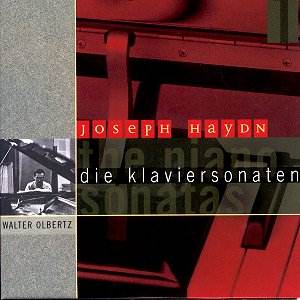 |
Joseph HAYDN (1732-1809)
|
In his long lifetime Haydn spanned the late baroque and early classical eras, and encompassed the introduction of the piano (or, more precisely at that time, the fortepiano), which was already set to render the plucked keyboard instruments of earlier periods obsolete. Though associated with the development of formal sonata structures in his symphonies, in other respects Haydn was an unorthodox composer for his time. He was allowed considerable creative freedom by his patrons, and his fertile imagination is well represented in the piano sonatas. The whole cycle paces the emergence of the piano as an entirely new instrument capable of such profound works as those of Haydn's pupil, Beethoven.
But first a few nettles, such as the confusing matter of authentication, need to be grasped. This box follows the numberings of the 52 sonatas in Hoboken's 1957 catalogue of Haydn's works, some originally published under titles such as "partita" and "divertimento", as does my Dover edition of the complete sonatas. These are more reliable than the spurious opus numbers occasionally allotted to them, but the catalogue of Haydn's works compiled by George Feder for the 1980 edition of the New Grove Dictionary of Music and Musicians classifies eleven as "doubtful", and two as "definitely spurious". Composition and publication dates, where given, are similarly unreliable. Furthermore the absence of any useful information with this set concerning the works themselves (even the discs are not numbered) makes playing the sonatas in anything like a correct sequence must be deplored,
Such niggles aside, what about the performances? The approach that Obertz takes to works that, in the mid seventies, were still regarded as so much "early music" ripe for updating, is courageous, and largely successful in maintaining Haydn's reputation as an exciting, as well as influential, figure. His flexible, sparkling technique is well suited to what are essentially late 18th-century keyboard compositions and, notwithstanding our current love affair with "historically informed" performance, the sonorities of a modern concert grand preserve - may even enhance - the composer's intentions. In short this fascinating interpretation was well worth preserving in digital format.
The earlier sonatas - from, say, Nos. 1 to 18 - could reasonably be called sonatinas and, while displaying Haydn's ready wit and joie de vivre, are fairly rudimentary in form and style, though they stand up well against other representatives of the early Viennese school of pianist-composers such as Clementi, Diabelli, Dussek and Hummel. The later ones show Haydn's growing confidence in the dynamic possibilities the instrument, and draw ever closer to the grand designs of his one-time pupil Beethoven. As the writing grows more adventurous so does the harmony become fuller and the counterpoint bolder. The fluency and easy good humour is undiminished, but the piano sonata is emerging from its chrysalis. By No. 10 we have arrived at a clearly "pianistic" treatment of his material; yet even this sonata, with its signed or fully written out ornamentation (a practice Haydn followed throughout the cycle), is reminiscent of Scarlatti and, by the way, sounds quite effective when played on a harpsichord. This flirtation with earlier styles continues, as in the tenderly beautiful No.40 in G minor, but thereafter things get more exciting. The quirky first movement of No. 32 in B minor, with its rippling triplets and sextuplets, and the Chopinesque arabesques of No. 38 are bold for their time and demand subtle interpretation. Obertz is constantly alert to such opportunities for pianistic coloration, and by the time we reach Nos. 46 and 47 we have shared Haydn's journey and are prepared for the late sonatas, such as the Beethovenian solemnity of No. 48 and the quirky No. 50 with its daring modulations.
I listened to all nine discs - over nine hours of music - in two sittings with undiminished pleasure and anticipation. Edel must be congratulated for rescuing these treasures from Deutsche Schallplatten's East German (then GDR) archive and making them available in this excellent transfer at a time when many baroque/early classical labels are treading safer, less interesting, paths. Top marks for performance and sound; hardly any for sophisticated packaging.
Roy Brewer